Notes
Scenes from Work as Photographers Increasingly Caught Up in the Protests They Cover
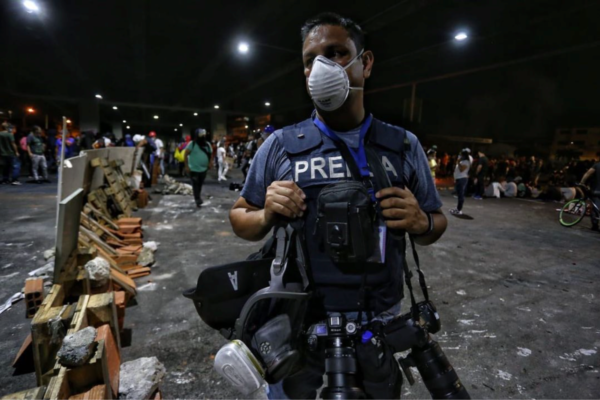
Photo: Santiago Saldarriaga
“Working…”
That’s how AFP photographer Luis Robayo captions two Instagram posts featuring recent images of himself on assignment covering protests in Colombia (1, 2). The protests started in opposition to a tax reform bill and then quickly escalated into expressions of outrage against police violence, government corruption, a poorly handled pandemic, and increasing poverty.
Most of Robayo’s photographs look a lot like others we’re seeing from Colombia in recent weeks: mass gatherings of people holding signs and waving Colombian flags, police officers in riot gear looming out of clouds of tear gas or advancing behind plastic shields, demonstrators blocking roads and confronting officers. Those pictures also look a lot like photographs from mass demonstrations around the world.
In this way, they are part of a global visual vocabulary of mass movement. Flags and their colors change. Words printed on police uniforms shift to suit local languages. Protesters use different materials in self-defense. But in their repetition and ubiquity, such photographs remind us that strategies of control and resistance are part of a pattern that is transnational.
Robayo’s “Working…” Instagram posts are noteworthy because of how they break from that pattern. These pictures that show the photographer himself caught up in the situation remind us that photojournalists are within, not outside of, the events they cover. It’s not surprising that mainstream news outlets rarely publish photographs of their own journalists, nor is it unusual for a social media account to feature pictures of its user. However, in a moment when we increasingly hear about journalists being targeted as they cover protests, Robayo’s photographs of himself working offer a direct, sometimes whimsical, and absolutely necessary look at the human experience behind protest photography.
In the photograph above, Robayo is standing next to a barrier at night. The area immediately around him appears empty, but crowds linger in the background underneath phantom street lights. Robayo seems weighed down with equipment. The white “PRENSA” (Press) on his vest is obscured not just by the camera bag and his two cameras, but also because he is carrying two different gas masks. He is wearing a third mask — a particulate mask — presumably to protect himself against COVID-19. All these items are tools of his trade, necessary equipment these days for any journalist following clashes between protesters and the state — wherever they may be.
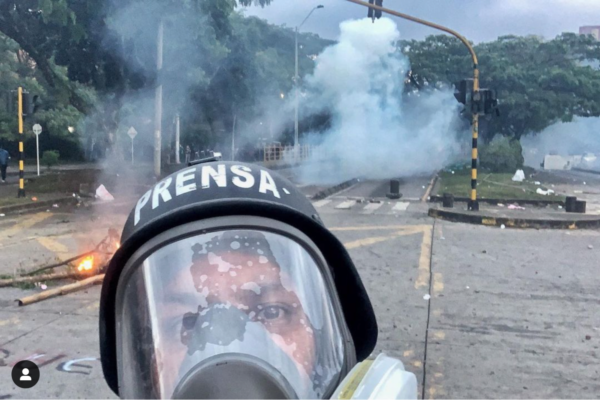
Photo: Luis Robayo.
Robayo’s other “Working…” post is a selfie backdropped by an empty but recently occupied street in Santiago de Cali. His gas mask-shrouded face, topped with a “PRENSA” helmet, peers over the bottom edge of the photograph. In an abandoned intersection behind him, a fire blazes and a cloud of smoke–from the fire? from a tear gas canister?–wafts by. Robayo, meanwhile, stares directly at the camera, inviting viewers to take in the conditions of his work. A thicker haze in the background suggests there are confrontations continuing nearby, as people replying to his post seem to confirm: “be careful!” “take care!” they urge. What’s a worksite is a protest is a war zone.
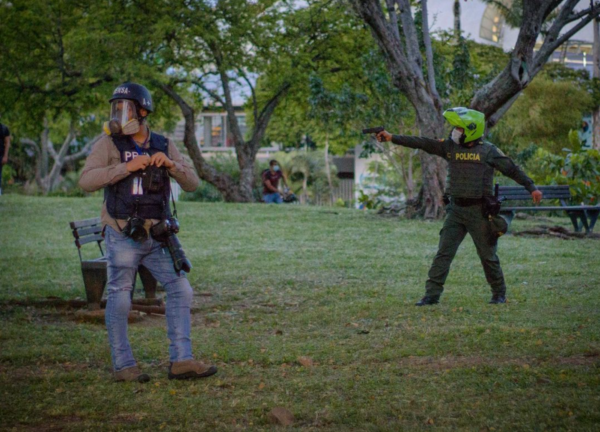
Photo: Sebast Marmolejo
If we needed any more evidence of how photojournalists are caught up in these confrontations — documenting, participating, implicated — this last image ought to provide it. Last September during a protest against police brutality in Cali, Colombia, photographer Sebast Marmolejo made yet another picture of Robayo working. The depth of field is clear enough to know that the officer’s gun doesn’t threaten Robayo, and yet the image implies a standoff: photographer in protective gear on one side, a police officer in protective gear on the other. Both figures can shoot, but only one can kill.
Robayo, in his Instagram post, expresses shock at the image, having not realized in that moment just how close he was. Marmolejo’s post with the same image hints at critique. He explains, “en ese momento un colega periodista pasa frente a el desapercibido de lo que pasa a sus espaldas” (“in this moment, a journalist colleague passes in front of [the police officer] unaware of what is happening behind his back”).
Photojournalists from Colombia to Palestine to Belarus to the United States create what have become mundane images of events that are far from mundane. (Ironically, in this case, Robayo’s “Working…” posts of such mayhem are tagged to #everydaylatinamerica, part of the popular international “slice-of-life” photography series.)
Pictures of state violence, mass protests, and insurgent resistance around the world have become commonplace. It would be easy to see the photographs, the events, the people, and the places, as interchangeable. I appreciate Robayo’s posts of himself for their reminder that the photographs are absolutely not interchangeable and neither are the scenes they depict. In a moment when journalists are targeted for arrest and violence as they bring attention to police brutality around the world, we need that reminder of particularity and ubiquity more than ever.
— Christa Olson
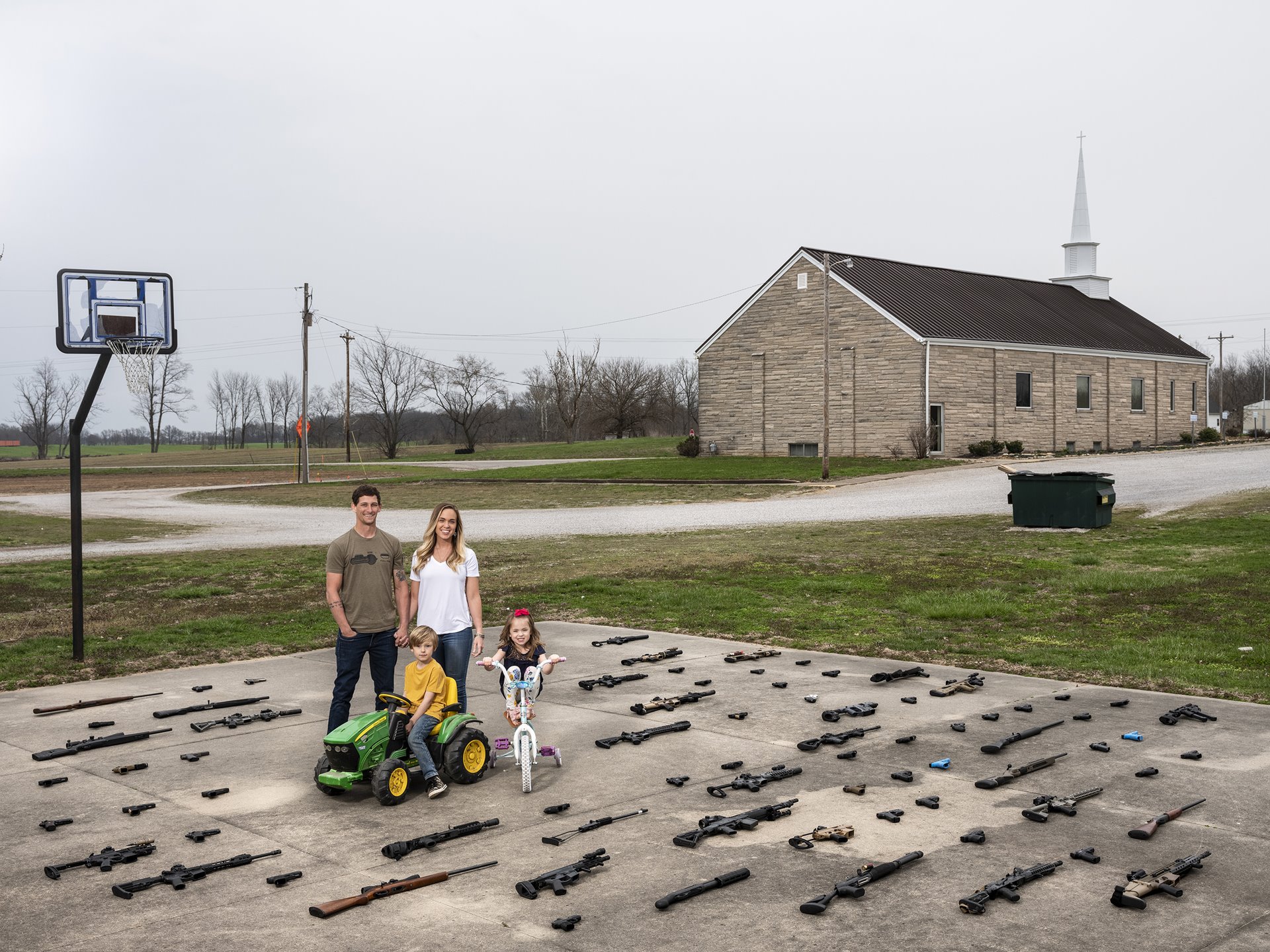
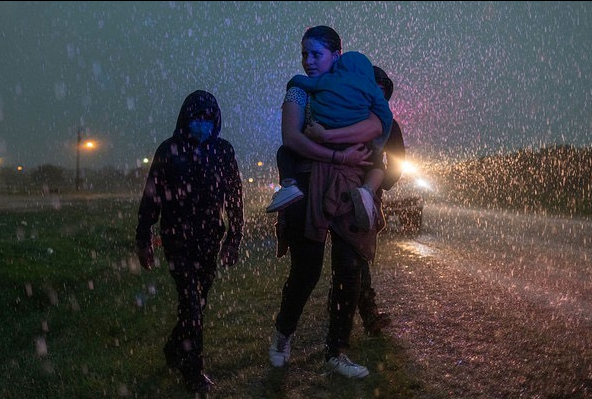
Reactions
Comments Powered by Disqus